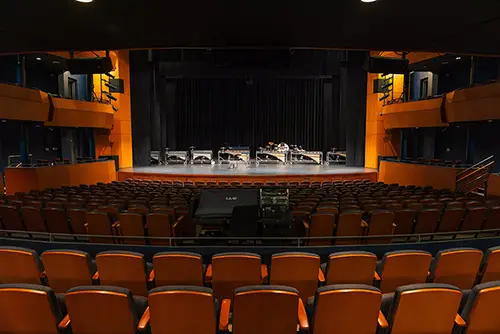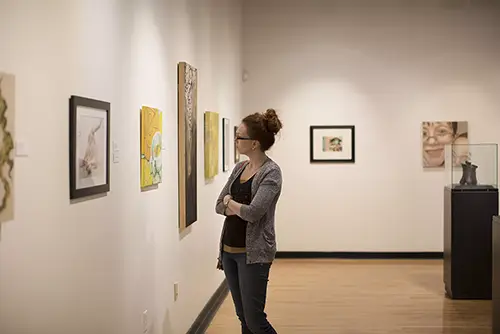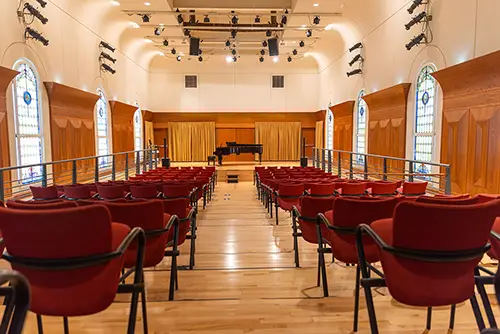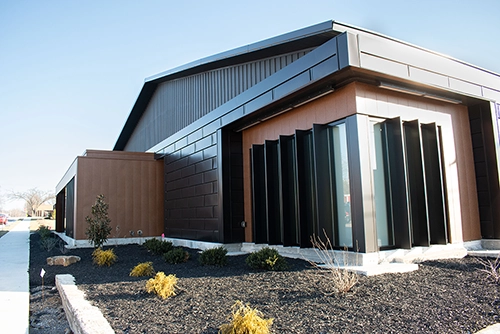The River Campus is Missouri’s only campus dedicated to art, dance, music, and theatre.
A Campus Dedicated to the Arts
The River Campus is home to the Holland College of Arts and Media, a world-class entertainment and education venue. The River Campus is the only campus dedicated solely to art, dance, music and theatre in Missouri. Unlike many universities that house these disciplines in facilities across campus, Southeast provides a unique opportunity for artists of all talents to spend time and create together.
The River Campus is a vibrant community of gifted artists, musicians, actors, performers, and dancers. Combine that with professional quality productions, experiental learning, guest speakers, and master classes and you will discover unlimited opportunities to launch your arts career.
River Campus by the Numbers
-
5
Accredited Programs
We are still the only school in Missouri holding accreditations in art, interior design, music, theatre, and journalism.
-
3
Professional Performance Venues
In addition to numerous creative and practice spaces, the River Campus is home to three professional quality performance venues, including the 950-seat Bedell Performance Hall, the Rust Flexible Theatre, and the Shuck Music Recital Hall.
-
3
Professional Galleries
River Campus offers multiple venues to create and experience art. The Nest Gallery features group shows for emerging artists, while the Main and Wolz Ruzicka Galleries highlight professional work. The Crisp Museum hosts professional exhibits, the Senior Showcase, Student Juried, and High School Exhibitions.
-
100+
Performances & Events
The River Campus isn’t just about creating but about sharing that creativity. What better way to give students hands-on experience than by taking their craft to the professional level. From musicals to award-winning theatre to traveling exhibits to world premieres, the stages and studios are home to the best music, dance, theatre, and art available.
World Class Entertainment
Each year, the Holland College of Arts and Media puts on hundreds of events from Broadway musicals to symphonies from jazz festivals to art exhibitions, whatever entertainment is calling you, we have just the ticket.
A Glimpse at the River Campus
On May 27, 1998, the Southeast Missouri State University Board of Regents requested and received approval from the University Foundation to purchase the buildings and grounds of St. Vincent’s College and Seminary from the Priests of the Congregation of the Mission, a Roman Catholic religious community established in France by Saint Vincent DePaul. The property had been for sale for several years, and the buildings had been unoccupied since the early 1980s. Nearly nine years later, after many feasibility studies and arduous planning, Southeast Missouri State University moved its Earl and Margie Holland College of Arts and Media to the River Campus.
Founded in 1838 and situated on the banks of the Mississippi River in Cape Girardeau, St. Vincent’s College and Seminary was responsible for the education of thousands of students, especially young men aspiring to the priesthood. The cornerstone of the first building of the Seminary was laid in spring 1843. In 1871, a three-story west wing was added to provide dormitory space and to create a large chapel and lecture room.
Declining enrollments in the 1890s nearly forced the closing of the college. Around 1910, however, the role of the school was redefined, and it became a type of preparatory school for the priesthood. Relatively healthy enrollments of 70 to 80 students became the norm. Young students at the college seemed to integrate increasingly into the local culture in the 1950s and years following, particularly as participants in sports activities.
The property acquired by Southeast in 1998 included 60,000 square feet of existing interior building space and 16.6 acres of real estate. Mr. B.W. Harrison, a local businessman and long-time supporter of the University, donated the funds allowing the purchase of the property. In addition, he provided monies to allow the planning process to begin. From the outset, Mr. Harrison expressed his wish that the property be preserved and used for educational purposes.
Donald Dickerson, president of the University Board of Regents in 1998, noted that during negotiations for the acquisition of the Seminary property, meetings were held with civic and community leaders of Cape Girardeau. Eventually, the University and the City of Cape Girardeau came together in a joint partnership to provide public and private funding for the new facility which would be home to a newly-created School of Visual and Performing Arts, later becoming the Holland College of Arts and Media, comprised of the academic departments of Art, Music, and Theatre/Dance. Also included were plans to bring the University Museum into the River Campus complex.
The University developed preliminary plans and a conceptual model of the new campus in summer of 1998 to arrive at a configuration of buildings that would best serve the delivery of academic programs while providing suitable venues for performances by outside touring shows. There had been keen interest expressed by both the citizens of the Southeast Missouri region and the University to build a venue which would serve not only as a training ground for students but also a location at which to offer cultural events of a national and international magnitude. Earliest configurations included a large performance theatre, a museum with a regional history focus, a 500-seat theatre, a 150-seat recital hall, and classrooms, offices and studios. In November 1998, the citizens of Cape Girardeau voted to help fund the River Campus project by approving the contribution of $8.9 million in restaurant and motel taxes to support the project in return for some public use of the facility.
A groundbreaking ceremony was held at the River Campus on May 27, 2003. In attendance were U.S. Senator Kit Bond, Congresswoman Jo Anne Emerson, Cape Girardeau Mayor Jay Knudtson, Missouri Senate President Pro Tempore Peter Kinder, University President Kenneth Dobbins, and University Board of Regents President Don Dickerson, as well as representatives of the Missouri Department of Economic Development. Also attending were many private donors and over 700 citizens from the Southeast Missouri region. A final schematic design was presented Oct. 15, 2003, by Jacobs Facilities, Inc. of St. Louis. Theatre Project Consultants of South Norwalk, Conn., was contracted to configure the performance spaces. Plans included a large proscenium theatre with acoustic variability of 950 seats, a flexible theatre of 204 seats with telescopic risers and platforms in the seating pit, and a dance studio of about 1,835 square feet. The Seminary chapel was earmarked to be the new Music Recital Hall with special acoustical design proposed by Ove Arup & Partners, Ltd., of California.
In January 2005, construction documents were completed to the extent that advertisements for demolition of the old gymnasium and site work packages could be distributed for bid. Initial estimates indicated the three-year renovation/construction phase would generate some 263 new jobs for two years and 132 jobs in the third year, with the construction alone generating approximately $23.1 million in direct and indirect personal income. The economic boost to the community by visitors to the Regional Museum and other arts events could generate an additional $900,000 in the Cape Girardeau region.
At nearly the same time, the Seminary was awarded special status by being listed on the National Registry of Historical Places. The renovation and reconfiguration of old buildings presents special challenges. The Seminary building underwent rigorous inspection during the course of the renovation. Because Cape Girardeau is located on the New Madrid fault line, the likelihood of a future seismic event could not be discounted. As a result, BSI Constructors of St. Louis drilled 55,000 horizontal holes into existing brick walls into which steel rods were secured with epoxy. These walls were then covered with “shot-crete” to create walls within walls. The structures are designed to survive a “Level I” seismic event.
Since the Seminary building is located adjacent to a highway bridge and a railroad, special care was taken to insulate offices, studios, and performance spaces from outside noise. In most instances, specially constructed sound isolated double-paned windows have been installed at the facility. Special sound insulation is also used around the music practice rooms and the studios of music instructors. All theatre entry is through double-doored “sound and light locks.” The spacious Seminary Chapel, now converted to the Shuck Music Recital Hall, also has sound-insulated windows. As a special feature, the old stained glass from the original chapel has been remounted and is placed on the inside of the chapel window frames.
Work on the Seminary was completed by the end of April 2007. The move of faculty offices for the Departments of Art, Music, and Theatre and Dance was completed mid-summer, 2007. Fall classes began in the Seminary Building Aug. 20, 2007. The University Board of Regents met for the first time in the new Seminary Building May 11, 2007, to officially name various venues on the campus including The Earl and Margie Holland College of Arts and Media, the Donald C. Bedell Performance Hall, the Rosemary Berkel and Harry L. Crisp II Southeast Missouri Regional Museum, the Wendy Kurka Rust Flexible Theatre and the Robert F. and Gertrude L. Shuck Music Recital Hall.
A grand opening of the entire facility was held Oct. 23, 2007, to coincide with Homecoming.
The River Campus Board of Managers advises the use of the River Campus. This includes proposing written policies that become effective when approved by both the University and the city. This cooperative group is comprised of an equal number of appointees from the City of Cape Girardeau and Southeast Missouri State University.
Representatives are appointed for three-year terms by the City Council and the University Board of Governors.
Meetings
Meetings are held quarterly at noon on the first Friday of the month; however, the date and time are subject to change based on board member schedules or for other reasons. These are open to the public and publicized in advance on the public notice bulletin board in Academic Hall.
Minutes
2025
2024
2023
2022
2021
2020
2019
2018
Membership
The Board of Managers is comprised of six appointees who are elected for three-year terms. Three members are selected by the City Council and three by the University Board of Regents. Current Members include:
City Appointees
Danielle Poyner
Dr. Kenneth Haskin
Lauren Jones
University Appointees
Rhonda Weller-Stilson - Dean of the Earl and Margie Holland College of Arts and Media
Brad Koester - Major Gift Officer, University Advancement
Bruce Skinner - Associate Vice President of Student Life, Campus Life
Campus Maps
- River Campus Cultural Arts Center
- Rosemary Berkel Crisp and Harry L. Crisp II Museum
- River Campus Seminary
- Dobbins River Campus Center
- Marching Band Annex
- River Campus Arts Complex
Parking
Free parking for campus visitors is available in the large northwest lot, the smaller north lot and, for most occasions, the smallest southwest lot. Handicapped and daytime visitor parking is located in the northwest lot. For performances which draw a large audience, overflow parking is available on Fountain and Morgan Oak Streets. Street parking is available for the new Art and Design Complex. Questions about parking should be addressed to the box office at (573) 651-2265.
Directions from Main Campus:
Take West End Boulevard, Henderson Street, Pacific Street or Sprigg Street south to Broadway Avenue. Turn left onto Broadway and proceed east to Spanish Street. Turn right onto Spanish and proceed south to Morgan Oak Street. Turn right onto Morgan Oak. River Campus will be immediately on your left. To proceed to the new Art and Design Complex, remain on Morgan Oak to Frederick Street. Turn right onto Frederick. The new Art and Design Complex will be immediately on your right.
Directions from West:
Take Missouri Route 60 east to Interstate 55. Proceed as directed in "From North or South" below.
Directions from North or South:
Take Interstate 55 to Exit 95 in Cape Girardeau. From either direction, turn right at the top of the exit ramp onto Missouri Route 74. Continue east on MO-74 about three miles. Just before crossing the Bill Emerson Memorial Bridge into Illinois, turn left onto South Fountain Street. River Campus will be immediately on your right. To proceed to the new Art and Design Complex, continue north on South Fountain Street. Take the roundabout to the left. Proceed west to Frederick Street. Turn right onto Frederick. The new Art and Design Complex will be immediately on your right.
Directions from East (Illinois):
From Interstate 57, take Exit 30 (from Interstate 24, take Exit 16). Follow Illinois Route 146, west toward Anna. Stay on IL-146 through Anna, toward Missouri. Cross the Bill Emerson Memorial Bridge. IL-146 becomes MO-74. After crossing the bridge, turn right onto South Fountain Street. River Campus will be immediately on your right. To proceed to the new Art and Design Complex, continue north on South Fountain Street. Take the roundabout to the left. Proceed west to Frederick Street. Turn right onto Frederick. River Campus Art and Design Complex will be immediately on your right.
Technical Specifications for the Donald C. Bedell Performance Hall are available in pdf format.
The conference room on the third floor of the Seminary Building may be rented for meetings throughout the year, subject to availability. Maximum seating is 18. Similarly, four classrooms of various sizes may be rented for presentations, lectures, or break-out sessions, subject to availability. Tech packages are available.
The Atrium, located immediately outside the Bedell Performance Hall, is rented only to civic groups or organizations, subject to very limited availability. The space may not be reserved for personal events, i.e., weddings, wedding receptions, anniversaries, or the like at any time during the year and is never rented when performances are scheduled.
The Robert F. and Gertrude L. Shuck Music Recital Hall is the principal performance venue for the Department of Music. It is heavily scheduled with rehearsals, recitals, and performance classes during the academic year. For that reason, it is not available for rental from August to May. It may be rented only for lecture or concert events. It may not be rented for weddings, wedding receptions, or other personal events.
The Wendy Kurka Rust Flexible Theatre is the principal performance space for theatrical productions of the Dobbins Conservatory of Theatre and Dance. It is heavily scheduled with rehearsals, plays, student-directed productions and classes during the entire year. For that reason, its rental availability is extremely limited. It may be rented only for lectures or small stage events. It may not be rented for weddings, wedding receptions, or other personal events.
The River Campus also includes a beautiful park area on the east side of the campus with stunning views of the Mississippi River and Bill Emerson Memorial Bridge, making it the perfect spot for gathering.
River Campus Procedures Manual
This document details scheduling, catering, and utilization information. Contact our office by email or phone for specific pricing information based on your needs and to check for availability.
Nikki Evans, House Manager
Phone: (573) 651-2573
Email: nevans@semo.edu
Southeast Missouri State University works cooperatively with Chartwells' catering services, a full-service, licensed and insured caterer. Chartwells provides a wide variety of dining and bar services that include tables and linens. All food and beverages at River Campus facilities can be ordered directly through their online service or by calling (573) 651-2511.
Cape Girardeau, MO 63703
Cape Girardeau, MO 63701












